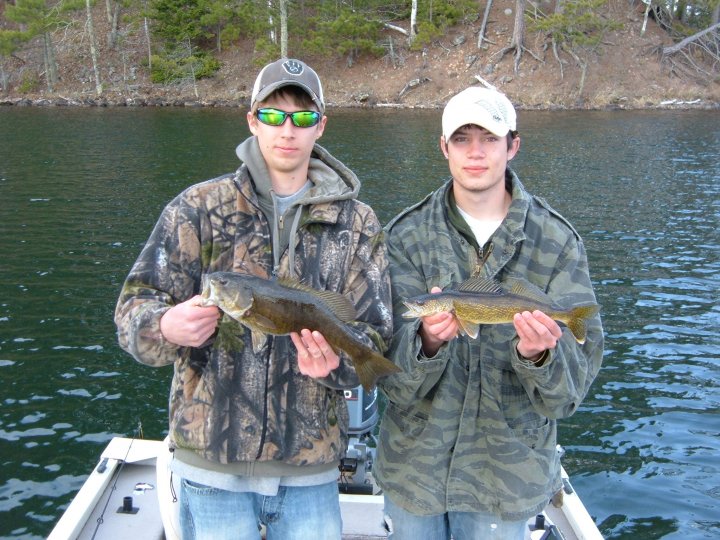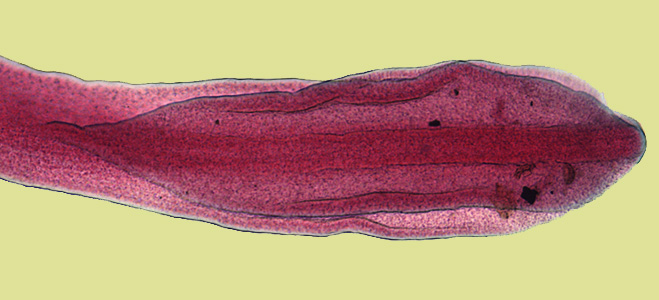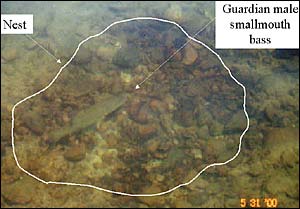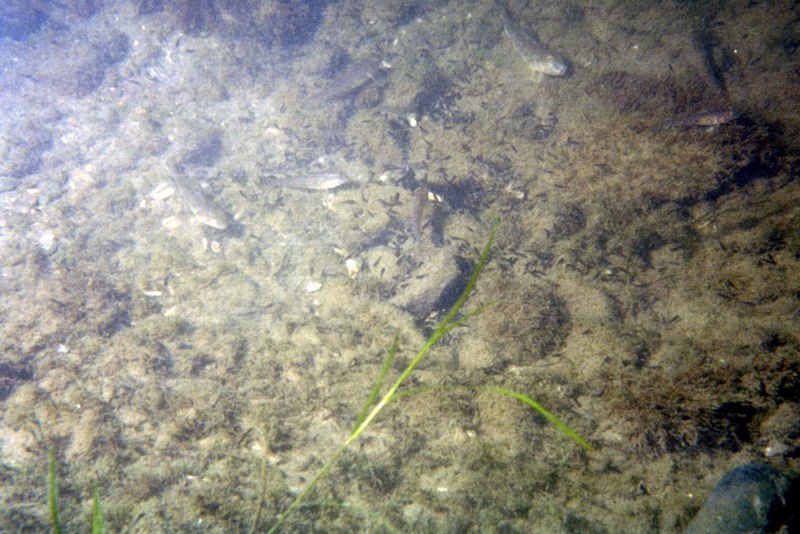SMALLMOUTH BASS
(Micropterus dolomieui)
Dustin Hetke
BIO 203: Organismal Biology, UW-La Crosse
Interspecies relationship dynamics
As a full-grown adult, the smallmouth bass serves an
important ecological niche as an upper-echelon predator within
many natural freshwater ecosystems. To find out more
about the numerous types of organisms that comprise the
smallmouth’s diverse diet, please see
Diet & metabolism. The following food web is an
ultra-generalized schematic representation of my construction,
covering a wide breadth of different freshwater habitats that
may provide a home for smallmouth bass. Please keep this
in mind rather than assuming that all of these organisms are
always present together within a single lake, river, or
reservoir ecosystem. A few organisms may also be missing
from this figure, although they could be part of a real
smallmouth food web. Depending on your perspective, humans
may be considered overridingly dominant over the entire food
web. The arrows simply depict “who eats who.” While
not apparent in this figure, many animals, such as the large piscivorous fish, regularly consume other organisms occupying
the same trophic level. The point to remember: when it
comes to real food webs, they are always more complex than one
can illustrate on a computer; there are almost always exceptions
to the rules!
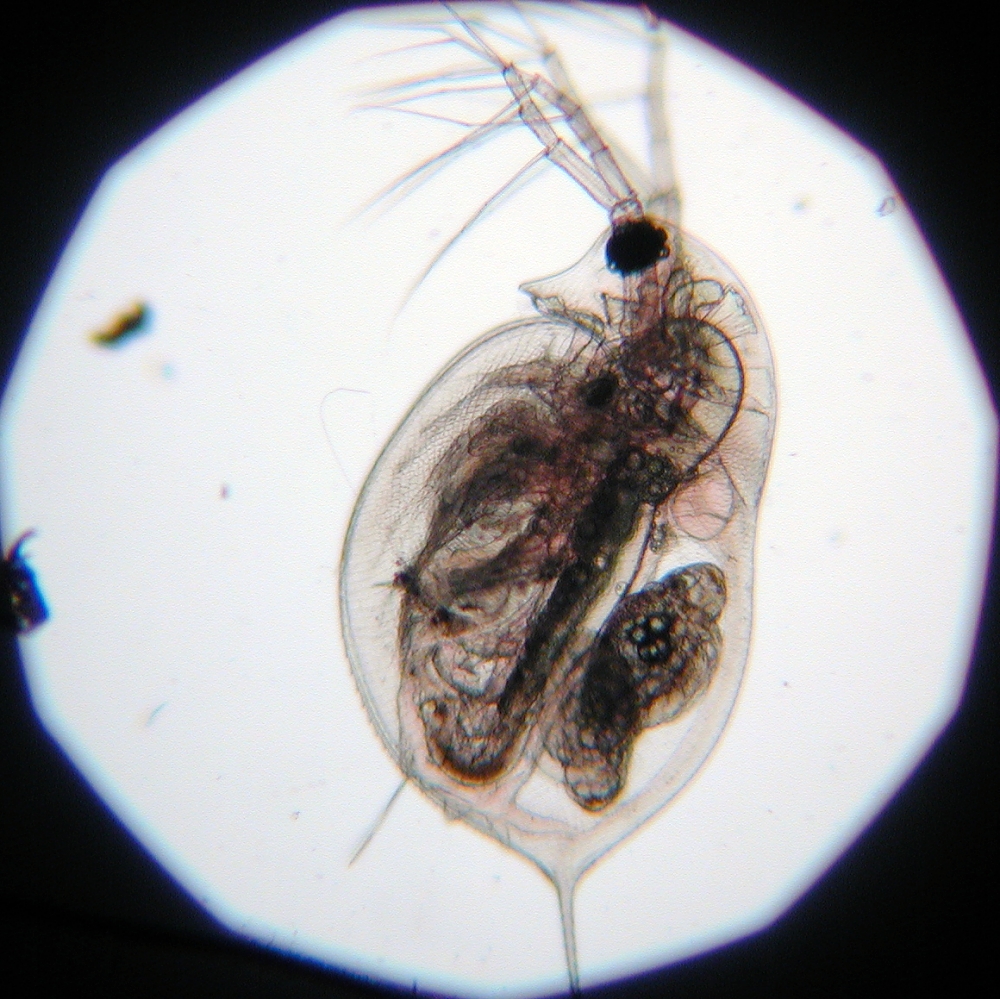 Within the smallmouth’s ecosystem, the base of the food web
is always
comprised of aquatic plants,
algae,
diatoms, and
other phytoplankton,
Within the smallmouth’s ecosystem, the base of the food web
is always
comprised of aquatic plants,
algae,
diatoms, and
other phytoplankton,
which
serve as primary producers. Next up are organisms that consume
primary producers, which are primary consumers; these include a wide
array of microscopic animals
called zooplankton.
Water fleas
(Daphnia), one of which shown in the photo to the right, are among the most common types of
freshwater zooplankton.
Water fleas and other zooplankton comprise
a huge portion of the young smallmouth fry's diet.
Numerous arthropods (insects, crayfish, etc.) and mollusks then
feed upon these tiny organisms, along with countless other
water-dwelling invertebrates. Frogs, mudpuppies, and other
amphibians roam the next level of the
food web, along with
shiners and
other small fish. These primary game fish give rise to fish of
larger size, such as
yellow perch and
bluegills, which often include
smaller fish in their diet. Smallmouth bass, which often coexist
with other secondary game fish, actively prey upon the primary game fish
and other organisms that occupy the lower and middle trophic levels of
this complex food hierarchy. As it grows and matures, the
smallmouth bass gradually climbs upward in the aquatic food web.
As it makes this ascension, the smallmouth bass becomes a noteworthy
participant in a wealth of dynamic interactions that occur between it
and other other
organisms in its ecosystem.
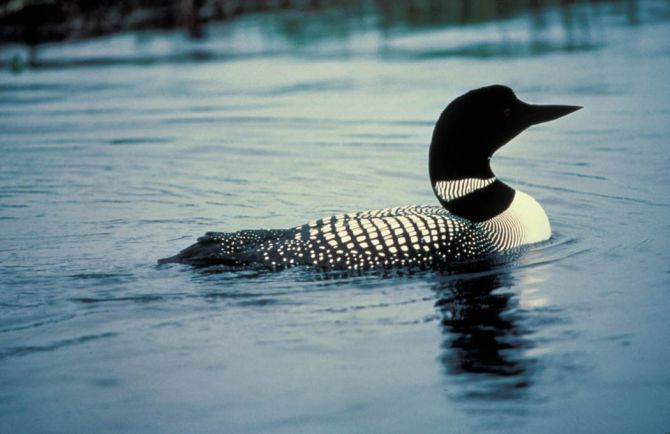 When it comes to predator/prey
When it comes to predator/prey
relationships, the smallmouth
bass
rarely serves the role of
prey. However, while mature
bass usually
reign within the top
of the food web, young fry and
juvenile smallmouth
can
become vulnerable prey items
for competitive populations of
other
predatory fish. Depending
on the particular body of water,
such
competitors may include
walleye,
muskellunge, lake
trout,
Northern pike,
or the
smallmouth’s closest relative,
the
largemouth bass.
Likewise,
young fry and juveniles of these competitor fish species are
susceptible to the wrath of a hungry, fully-grown smallmouth.
Aside from larger fish, few other animals are known to feed on the
smallmouth bass; potential non-fish predators include large birds
(kingfishers,
loons, blue herons),
snapping turtles, otters, minks, and
snakes. Still, under normal circumstances, these non-fish
predators prefer prey that is smaller, more inexperienced, and more
easily caught. A predator generally prefers to feed on prey that
requires less effort to obtain, as opposed to expending unnecessary
energy in chasing a more difficult prey item to no avail.
When coexisting populations of large piscivorous fish species are present, the size and age of an individual fish is a large determinant in whether or not it will eat or be eaten. A juvenile walleye may fall victim to a large smallmouth, and vice versa; therefore, neither species can be considered definitively dominant over the other in terms of predation.
A very young smallmouth preys upon even smaller organisms that occupy the bottom of the food web, such as phytoplankton, zooplankton, and insect larvae; at these early stages of growth, it is extremely susceptible to predation from almost any larger fish. As a juvenile, the smallmouth preys upon adult insects, annelids, small amphibians, crayfish, and an increasing amount of smaller fish; it remains vulnerable, although less so, to predation from larger piscivores. As a full-grown adult, the diversity and size of its quarry increases further yet; its susceptibility to other predators is virtually nullified by this stage in its life.
Still, coexisting populations of other fish species create much more than an interesting variety of predator/prey relationships. Frankly, many of the smallmouth’s prey items are also the mutual favorites of other predatory fish, which inevitably creates interspecies competition for food. This explains why the presence of competing fish species, along with the diversity and abundance of prey sources, is such an influence on which lakes, rivers, and reservoirs qualify as suitable smallmouth habitat. Aside from food, smallmouth must also compete with other fish species for the right to roam certain hunting areas and occupy spawning locations. Consequently, populations of coexisting fish species are often segregated by depth and geographic structure within their shared freshwater environment, which makes for varying accessibility to essential resources. Smallmouth in oligotrophic lakes may have to compete with lake trout, and sometimes walleyes; those in mesotrophic lakes most often compete with walleyes, and sometimes even largemouth bass. As a general rule, fewer competing predators allow the smallmouth to utilize wider ranges of habitat, creating more opportunities to feed and reproduce successfully. Ultimately, these ingredients make for a more successful and well-sustained population of smallmouth bass. From an evolutionist perspective, this competition also ensures that the most successful and well-adapted predators are able to pass their traits on to future generations. To learn more about which fish species may be present together in various freshwater habitats, please see Habitat range & characteristics.
Interestingly, some organisms within the smallmouth’s habitat are able to find ways to defy the unwritten rules of predation. Such is the case for a number of parasitic organisms that take advantage of opportunities to utilize the smallmouth bass as a host. Such parasites primarily include members of the phyla Platyhelminthes (flatworms) and Nematoda (roundworms), which require at least two hosts as parts of their life cycles. Parasitic leeches, which are Hirudineans of the phylum Annelida, may also be found utilizing smallmouth bass as hosts. The degree of harm inflicted upon smallmouth by these parasites is extremely variable, depending on factors such as the particular species of parasite and whether or not the smallmouth’s immune system has been compromised due to injury or environmental pollution. Usually, unless present in extraordinary numbers, these parasites are not life-threatening to the smallmouth. However, anglers and other people that enjoy eating fish must be careful not to consume the flesh of an infected smallmouth, as this can lead to some pretty gruesome pathology in humans.
Tapeworms (Cestodes) are flat worms that often find their way into the smallmouth’s digestive tract. Aquatic crustaceans are often utilized as primary hosts, providing the parasites with a gateway into the smallmouth due to the fact that crayfish are such a routine prey source. After being ingested along with the smallmouth’s prey, the tapeworm anchors itself to the inner walls of the intestines via a modified mouth structure called a scolex. After attachment, it absorbs some of the nutrients being digested by the fish across its body wall. Its eggs are then passed in the smallmouth’s feces, before being eaten by crayfish and starting the cycle over again. A photograph of the fish tapeworm Diphyllobothrium latum is shown above.
Most
flukes (Trematodes) are obligate parasites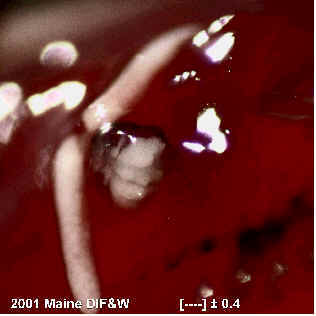 of mollusks, primarily
gastropods and bivalves, through which they tend to reproduce asexually
and in large numbers; unfortunately for the bass, crayfish and other
crustaceans may be used as hosts as well. After eating the
infected crayfish, smallmouth bass and other vertebrates are utilized as
secondary hosts, providing an environment that is suitable for the
flukes to reproduce sexually. Depending on the fluke
species, fluke cysts may occupy regions within the smallmouth’s stomach,
pyloric caeca, intestines, liver, muscle, or external areas like the
gills and skin. Much like tapeworms, roundworms (Nematodes) tend
to take residence within the smallmouth’s intestinal tract. They
are usually found encysted within the intestinal walls, mesentery, or
pyloric caeca. Like some flukes, they also find a way into the
smallmouth’s digestive tract by using crayfish as an intermediate. While
most crustaceans serve as intermediate hosts between parasites and bass,
a few of them actually exhibit parasitic behavior themselves. Copepods are tiny crustaceans that often comprise a large portion of a
young smallmouth’s zooplankton diet. However, half of all copepod
species are actually parasitic, producing larvae that have a strong
affinity for attaching to the smallmouth’s gills and exploiting them to
obtain energy for themselves. For example, members of the copepod
genus Ergasilus (shown above and to the right) pierce attach themselves
to the highly vascularized gill tissue and feed on the
underlying blood and bodily fluids.
of mollusks, primarily
gastropods and bivalves, through which they tend to reproduce asexually
and in large numbers; unfortunately for the bass, crayfish and other
crustaceans may be used as hosts as well. After eating the
infected crayfish, smallmouth bass and other vertebrates are utilized as
secondary hosts, providing an environment that is suitable for the
flukes to reproduce sexually. Depending on the fluke
species, fluke cysts may occupy regions within the smallmouth’s stomach,
pyloric caeca, intestines, liver, muscle, or external areas like the
gills and skin. Much like tapeworms, roundworms (Nematodes) tend
to take residence within the smallmouth’s intestinal tract. They
are usually found encysted within the intestinal walls, mesentery, or
pyloric caeca. Like some flukes, they also find a way into the
smallmouth’s digestive tract by using crayfish as an intermediate. While
most crustaceans serve as intermediate hosts between parasites and bass,
a few of them actually exhibit parasitic behavior themselves. Copepods are tiny crustaceans that often comprise a large portion of a
young smallmouth’s zooplankton diet. However, half of all copepod
species are actually parasitic, producing larvae that have a strong
affinity for attaching to the smallmouth’s gills and exploiting them to
obtain energy for themselves. For example, members of the copepod
genus Ergasilus (shown above and to the right) pierce attach themselves
to the highly vascularized gill tissue and feed on the
underlying blood and bodily fluids.
Aside from predator/prey relationships, competition for resources, and serving as potential hosts for parasites, the male smallmouth’s role as the protective guardian of his offspring presents another compelling example of interspecies interaction (see Reproduction: from spawn to brawn). After eggs are deposited in the nest and fertilized, they become embryos; when the young smallmouth hatch, they congregate in schools and continue to eat, grow, and develop in shallow rearing areas that are close to the original nest. The male smallmouth’s job, from the beginning to the end of the spring spawning period, is to guard these rearing areas and make sure that none of the eggs, embryos, or recently-hatched fry are stolen away or eaten by any opportunistic nest raiders.
He does not take this responsibility lightly, for it is vitally important to ensure the successful sustainment of his species; therefore, he will very aggressively defend his young against potential threats. Smallmouth eggs (and embryos) are high in protein content; because of this, they are a very tempting meal for almost any heterotrophic, opportunistic species that feeds. Potential raiders of immature smallmouth include many small fish (bluegills, yellow perch, white perch, round gobies), other larger fish (largemouth bass, Northern Pike, muskellunge), birds (herons, kingfishers, loons), frogs, eels, and snakes. As an example, packs of hungry bluegills have been known to employ some interesting tactics in pulling off heists of smallmouth eggs and embryos. One or two bluegills may try to distract the guardian smallmouth, while a few more sneak around the other side of the nest and briefly indulge themselves.
Round gobies (Neogobius melanostomus), an invasive fish species introduced to the Great Lakes via ballast water, are among several organisms that eat embryonic and infant smallmouth when the opportunity presents itself. This can have a detrimental effect on indigenous smallmouth bass populations, which already suffer enough loss from indigenous nest raiders, and create imbalance in aquatic ecosystems. The following photograph shows round gobies caught in the act of nest sabotage:
Having already covered a wide variety of interactions between smallmouth bass and other organisms, this page would be drastically incomplete without addressing the reality of human interference, particularly from fishing during the spawning season. The detriment caused by human anglers which catch and remove male bass from their spawning beds, either temporarily or permanently, is undeniable and well-documented. While you are reeling and unhooking Mr. Bass, it may only take nest raiders a matter of minutes to consume all of the embryos present, which can cause a substantial reduction in the smallmouth populations and hinder the success of future generations. The same concept applies to the removal of a female smallmouth that has yet to lay her eggs; if she is caught and removed prior to spawning, an entire generation of smallmouth bass is never allowed a chance to live. For these reasons, bass angling is strongly discouraged during the spawning period, by bass enthusiasts and naturalists alike, for purposes of ensuring the success and survival of this species long into the future.
Many people enjoy keeping the occasional smallmouth bass to cook and eat for food. Others that catch trophy-sized specimens may desire to bring them home and have wall mounts done as well. For the last ten years or so, I have operated exclusively by the catch, photo, and release principle at all times of the year. The only exception I have made came with the smallmouth bass that I caught and removed from the Mississippi River this spring, for purposes of dissection and anatomical examination. While the removal of a single fish usually doesn’t warrant any serious concern, it took all the willpower I had not to release that fish. In fact, I actually did release it the first time it was caught, only to hook it again. I took this as a sign of divine intervention, in that this particular specimen was indeed destined to fulfill its purpose as a very special contributor to the information and photographs found on this web site. Yes, I find it very rewarding to look back and enjoy the memories of some very nice fish that I have caught over the years. Even more rewarding, however, is reminiscing in the knowledge that nearly all of the fish I have caught are still swimming, reproducing, growing, and able to be caught again on another day. Catch and release practices are especially appropriate for smallmouth bass, whose populations are not as abundant and widespread across the country as largemouth and many other game fish species. While I am not particularly fond of eating bass, I cannot deny that I would jump at the opportunity to keep a trophy-sized specimen for a wall mount. In my opinion, these are not necessarily unethical practices (outside of the spawning period) so long as they are kept to an absolute minimum. By practicing catch and release, anglers like me can preserve the recreational enjoyment of smallmouth bass fishing as a gift that keeps on giving.
If you would like to find out more about me, see About the author.
(Return to home page)

